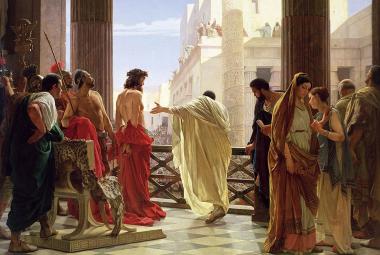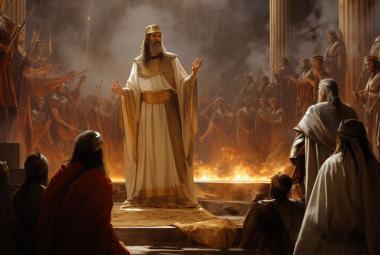This true story is distributed to schoolchildren in New Zealand as part of their Maori heritage...
Tarore
In 1835, The Bible Society published 100 copies of the Gospel of Luke in the Maori language. In 1836, missionaries gave one to a young Maori girl, Tarore, at a mission school near Matamata.
She read it to her father, the chief of the Waikato tribe. She kept her treasured copy of the Gospel of Luke under her pillow when she slept.
Under threat of a neighboring warring Rotorua tribe, the mission school was in the process of relocating to Tauranga. On October 19, 1836, at the Wairere Falls, a raiding party killed the 12-year-old girl and took the treasured object from under her pillow.
Later, unable to read, the Rotorua chief discarded it until a slave boy came along who had learned to read, and he revealed its contents to his fascinated listeners.
The Rotorua chief himself was convicted by its contents and resolved to become a Christian. He also re-solved to seek out the father of the murdered girl and beg for his forgiveness. This mission was, of course, life threatening. When finally confronting the father, the chief of the Waikato tribe—and risking the customary tribal response of revenge—the father of the murdered girl forgave him, and thus began a peaceful relationship between the two previously warring tribes!
A young girl murdered… A devastated father refusing to seek revenge… A murderer transformed through the Gospel he stole from his victim… Then forgiveness given and peace achieved!
The Good News Spreads
The story of this young Maori girl and her copy of the Gospel of Luke then became the key to the conversion of many of the Maori tribes. When missionaries visited both the North and South Islands, they discovered that many of the Maori tribes had already been converted to Christ due to the story of Tarore and her copy of the Gospel of Luke making its rounds…
The Treaty of Waitangi
On February 6, 1840, the nation of New Zealand was born by the signing of the Treaty of Waitangi between the Crown of England and the Maori tribes.
While primarily dealing with land rights and other issues, this foundational document continues to obligate the Crown of the United Kingdom to safeguard and protect the Maori’s rights of worship.
Since a significant portion of the Maori tribes had previously been converted to Christianity, the government now continues to be legally committed to protect Christianity in New Zealand. There are Bibles in schools, home schooling is encouraged, and many Christian schools receive significant government sup-port. (See New Zealand’s national anthem, left.)
It seemed appropriate that we recorded our most recent update of our exposition of the Gospel of Luke in New Zealand, where it has had such a unique and special historical impact.
The Gospel of Luke
The Gospel according to Luke has been called the most beautiful book ever written.1 At its heart is the perfect Life—Christ’s teachings, redemption through Him, and the changed lives of those who cluster around Him.
The religion of Israel could only produce a Pharisee; The power of Rome could only produce a Caesar; The philosophy of Greece could only produce an Alexander, an infant at heart; It was to this Greek mind that Luke wrote: he presents Jesus Christ as the perfect Man, the Universal Man, the very person the Greeks were looking for.
H.A. Ironside
For the Gentile Reader
Of the four Gospels, Luke’s seems to be the most popular to the Gentile reader. Luke is a Gentile, and as such he focuses on the reality that the Gospel is for all nations.
There are many Old Testament prophecies which foretold that the Gentiles would be beneficiaries of God’s kingdom. Luke helps us see through Matthew’s Jewish veil and presents to us a broader perspective.
Luke the Physician
Luke is a Greek physician, and as a physician, he is focused on Jesus’ humanity. As the “beloved physician,” he used more medical terms than Hippocrates, the father of medicine.
He has given us an obstetrical account by a doctor of the virgin birth, then he carries us through to the agony of the Cross and the miracle of the empty tomb.
Luke was chosen by the Holy Spirit to write this gospel—Luke’s Greek is the highest Greek in the New Testament, the best of any New Testament writer. His writings are regarded as some of the finest pieces of historical writing in ancient literature. Sir William Ram-say set out to disprove Luke. After diligent investigation, he concluded that Luke had not made one historical inaccuracy—his gospel is the most complete historically.
Special Features
Luke gives us many features omitted by Matthew and Mark: An obstetrical account of the virgin birth; 20 miracles, six of which are in no other gospel; and 23 parables, 18 of which are found nowhere else. It is Luke alone who mentions the coming of the angel to our Savior to strengthen Him during Gethsemane’s agony. And had it not been for Luke, we would never have known of the penitent thief, or of the visit of our resurrected Lord with the two disciples on the way to their home at Emmaus.
Parables that are unique to Luke’s Gospel include the story of the Good Samaritan, the rich fool, the barren fig tree, the great supper (not to be confused with the marriage of the king’s son as given in Matthew), the lost coin, the Prodigal Son, the unjust steward, the story of Lazarus, the unjust judge and the widow, the Pharisee and the publican, and the parable of the pounds (distinct from the ten talents). These are re-corded in Luke’s Gospel alone. And only Luke reports on the sending of the 70.
Paul’s Trial Documents?
There are some scholars who suspect that Luke’s Gospel—and its sequel, the Book of Acts (“Luke Volume 2”)—may have been required trial documentation.
Roman law required that the historical background of a case had to precede an appeal to Caesar. Such an undertaking was expensive and Theophilus may have been Paul’s sponsor.
We notice two interesting observations about Luke’s writings that corroborate this: first, uprisings were in-variably the fault of Paul’s Jewish adversaries; and second, centurions are always portrayed as the good guys.
Unique Discoveries
Our Expositional Commentary on Luke highlights some unique discoveries: we find remarkable textual insights regarding Jesus’ early years and some surprises in Mary’s genealogy yield a provocative analysis of the virgin birth. Most of what we know about the afterlife comes from Luke 16. And many scholars fail to realize that Luke 21 is not the Olivet Discourse (it involves similar idioms, but closer inspection will reveal a different audience, a different focus, and a different occasion altogether).
Many are unacquainted with the surprise that emerges in Luke 19, and why no Christians were among the million Jews slaughtered in the Fall of Jerusalem in A.D. 70.
Both Luke and John each appear to have set up their sequels: John’s sequel was penned at Patmos; Luke’s was the subsequent history of the early church known as the Book of Acts. In Luke’s Gospel, and its sequel, more details are given of the apostles and leaders of the early church than is found in any other document.
This most popular Gospel among Gentile readers in-variably yields a rich reward to the diligent. Good hunting!






